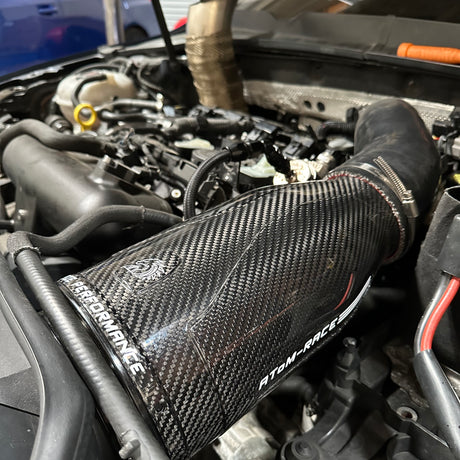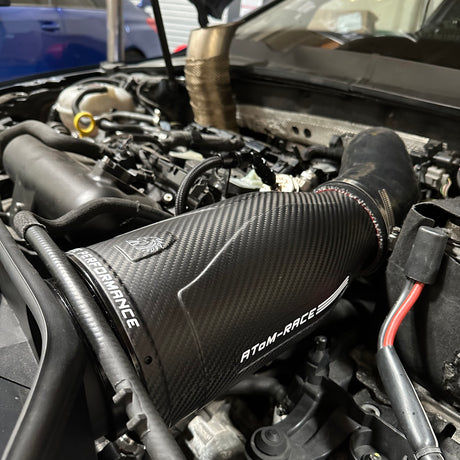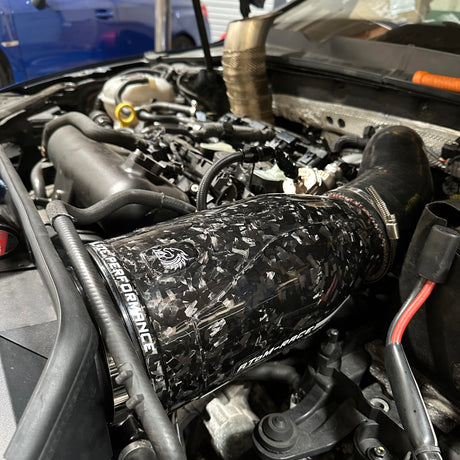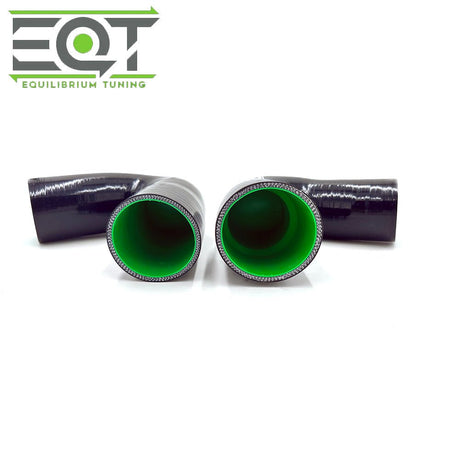EQT Staged ECU Tune - VW MQB Alltrack 1.8T (Mk7)
Shipping rates and applicable discounts are applied during checkout.
- Stage 1 / Stock HPFP & LPFP / 91/92oct
Please contact us to confirm support for 2014 Model Year MQB car
Couldn't load pickup availability
Description
Description
Description
The Mk7 platforms come with incredibly sophisticated engine management systems from the factory. Working with these ECU's requires an intimate knowledge of engine dynamics and software engineering to be able to properly understand and modify the functionality. Luckily, we have decades of experience in both fields and acquired our own Golf R as an R&D vehicle. We have been working very closely with Cobb Tuning through the development of their AccessPort and ProTuner software for this platform. This close relationship gives us early access to the newest features and input into further development and refinement of the system.
Using Cobb's ProTuner software, we have spent the past few years developing and refining our own set of staged tunes or "OTS tunes" for your MQB vehicle to be used with the Cobb AccessPort. Countless hours of in house dyno testing, drivability road testing, and track torture testing went into the development of our calibrations. So you can be sure your car will perform optimally while retaining excellent drivability characteristics and a healthy margin of safety built into every tune.
We go way beyond the standard fuel, boost, and ignition adjustments that are common in the tuning world. We spent the time to go through and map out the complete torque control system, the complex ignition control and knock detection systems, the sophisticated turbo and airflow modeling systems, the fuel management and injection timing systems, and countless other parameters. The end result can be felt any time you drive the car on a track, a fun road, or even for your regular grocery run. We generally see gains of 50-90whp over the factory calibrations depending on model and modification level. But along with those power gains, you will notice greatly improved throttle response, reduced turbo lag, and very smooth power throughout the powerband. We also offer all the custom features from Cobb. These include our own customized traction control system, flat foot shifting, and burbles/crackles.
When ordering, please select from the options listed for fuel quality, modifications, and special features you would like to be included in your tune. Please note that these maps are meant for the more basic Stage 1 and Stage 2 cars. If your car is more heavily modified and does not fall into the options available, we also offer custom e-tuning for just about any modification and fuel type available.
Power Estimates
This is a question asked all too frequently, and while we’d love to give you a specific number, there are many variables involved that can affect dyno results. Even taking the car’s modifications out of the equation, there are other variables such as weather, elevation, fuel quality, dyno type, dyno fan setup, etc. that come into play. With that being said, these are ranges that most vehicles will see, given standard modifications and reasonable conditions:
-
Stage 1 Golf/Sportwagen/Alltrack-A3 - 230-250whp
-
Stage 2: Coming Soon
Here are just a couple of examples of our tunes. Please note that these results were acquired on our Dynocom chassis dyno in 2WD mode and close to optimal conditions. Dyno numbers can vary greatly depending on dyno type and conditions. 
Burbles
Do you have Questions about our Burble Options? Visit our FAQ for additional Information
Ethanol Blended Fuels
Innovate Motorsports Flex Fuel Gauge Kits Available HERE.
When selecting E85 or Ethanol Blended Fuels, an Ethanol Content Analyzer is required. For more information, see our FAQ by clicking the icon below
Cobb Launch Control
For more information Click Here
How To Enable:
The vehicle will need to meet the following conditions for the ECU to allow it to happen.
- Coolant Temp Min-Max (160F - 250F)
- Engine Oil Min-Max (160F - 250F)
- Gearbox Oil Temp Min-Max (122F - 212F)
- EGT MAX (1835F)
- Steering Wheel Angle (within 20 degrees of being completely straight)
Steps to Use:
Manual Transmission
- Depress and hold the clutch pedal to 100%
- Move the shifter to 1st gear
- Depress and hold the gas pedal to 100%
- Once the rev limit has been reached, release the clutch pedal
DSG Transmission
- Depress and hold the brake pedal to 100%
- Move the shifter to Sport Mode
- Depress and hold the gas pedal to 100%
- Once the rev limit has been reached, release the brake pedal
Cobb Traction Control
For more information Click Here
How To Enable:
The ECU is not capable of remembering the value set in this adjustment after the car has been turned off or key-cycled. As such it will need to be set back to the desired value manually each time.
How it Works:
The COBB Custom Traction Control works in a manner similar to the factory offering, however it works much better and faster to minimize wheel slip and keep the car planted at all times. At it's simplest the software is looking at the various wheel speed sensors to determine if one is moving more quickly than others. When it detects that one wheel is moving at a higher speed than another, this is typically an indication of the wheel slipping. There are some instances where the wheels will move at different speeds (around corners for instance) but this is something tuned for in the map itself (you shouldn't need to worry about adjusting it to go around a corner properly). As the ECU sees the difference increase and detects a slip, it will reduce the amount of torque the engine is producing, this should slow down the wheel enough to grab on to the pavement again so you can continue accelerating. If it isn't able to regain traction, the ECU will continue to reduce power until it sees traction again. This means that with the traction control on the default setting where it minimizes any wheel spin the car is hypothetically the fastest as no wheel speed is ever lost.
Cobb Flat Foot Shift
For more information Click Here
Steps to Use: (Manual Transmission Only)
- Begin driving in any gear
- Depress and hold the throttle pedal to 100%
- As you approach redline, engage the clutch but keep the throttle pedal at 100%
- Shift the gear lever to the next gear in sequence
- Release the clutch and continue accelerating
In order to optimize traction, there are specific limits in each gear on the OTS maps.
| 1st | 4500 |
| 2nd | 4700 |
| 3rd | 4700 |
| 4th | 5000 |
| 5th | 5167 |
| 6th | 5334 |
Change Log - For the full change log click HERE
MQB 1.8T Staged Tunes: up to 287hp/370tq
Here are just a couple of examples of our tunes. Please note that these results were acquired on our Mustang chassis dyno with SAE correction. Dyno Results are uniform for Alltrack/Sportwagen/Golf/A3 1.8T IS12 powered vehicles.
Staged Tune Hardware Requirements
Stock Turbo Requirements
Stage 1
Stage 1
Performance Parts
- Stock / Upgraded Intake
- Stock / Upgraded Intercooler
- Stock Downpipe ONLY
Fueling Parts
- Pump Gas - Stock
- E30 -Stock
- E85 - 2.0T Vacuum Pump & HPFP
Stage 2
Stage 2
Performance Parts
- Upgraded Intake
- Upgraded Intercooler
- Upgraded Downpipe
Fueling Parts
- Pump Gas - Stock
- E30 -Stock
- E85 - 2.0T Vacuum Pump & HPFP

Why Tune With EQT?
- Easy-to-use, handheld device for monitoring, logging, and flashing.
- Flash your vehicle at home using the Accessport (does not need to stay connected to OBDII once the vehicle is flashed).
- Quick map switching in as little as 60 seconds via Accessport.
- Custom calibrations tailored for all climate conditions and elevations.
- Supports multiple fuel types: 91 through 94 octane, E30, and E85.
- Increased rev limiter and speed limiter removed (dependent on TCU tuning).
- Burbles (crackles, pops, and bangs) available below 4000 RPM and more aggressive above 4000 RPM.
- Supported upgrade paths beyond Stage 1 and Stage 2 hardware utilizing custom tuning.

Ongoing Tune Updates
Even though staged tunes are designed for a range of vehicles in various conditions, we don't take a "set it and forget it" approach. We’re always improving our tunes to deliver better throttle response, smoother power delivery, and reliability—so you can keep pushing your ride every time you drive. If you originally purchased an EQT Staged Tune, you can get each new update for just $25. Check out our staged tune change log here or click the button below to update your tune!

Ready For Change?
Ready to improve your setup with new mods or fresh software features? Our Option Changes let you adjust your current stage tune to match compatible hardware like EQT low-pressure fuel pumps, high-pressure fuel pumps, upgraded sensors, and more.
Want to tweak your driving experience even further? We can work with software settings like burbles, Cobb Launch Control, or even add (or remove) those crowd-pleasing DSG farts for the DQ381. Whatever your build calls for, we’ve got you covered without the need to buy an additional tune.


































